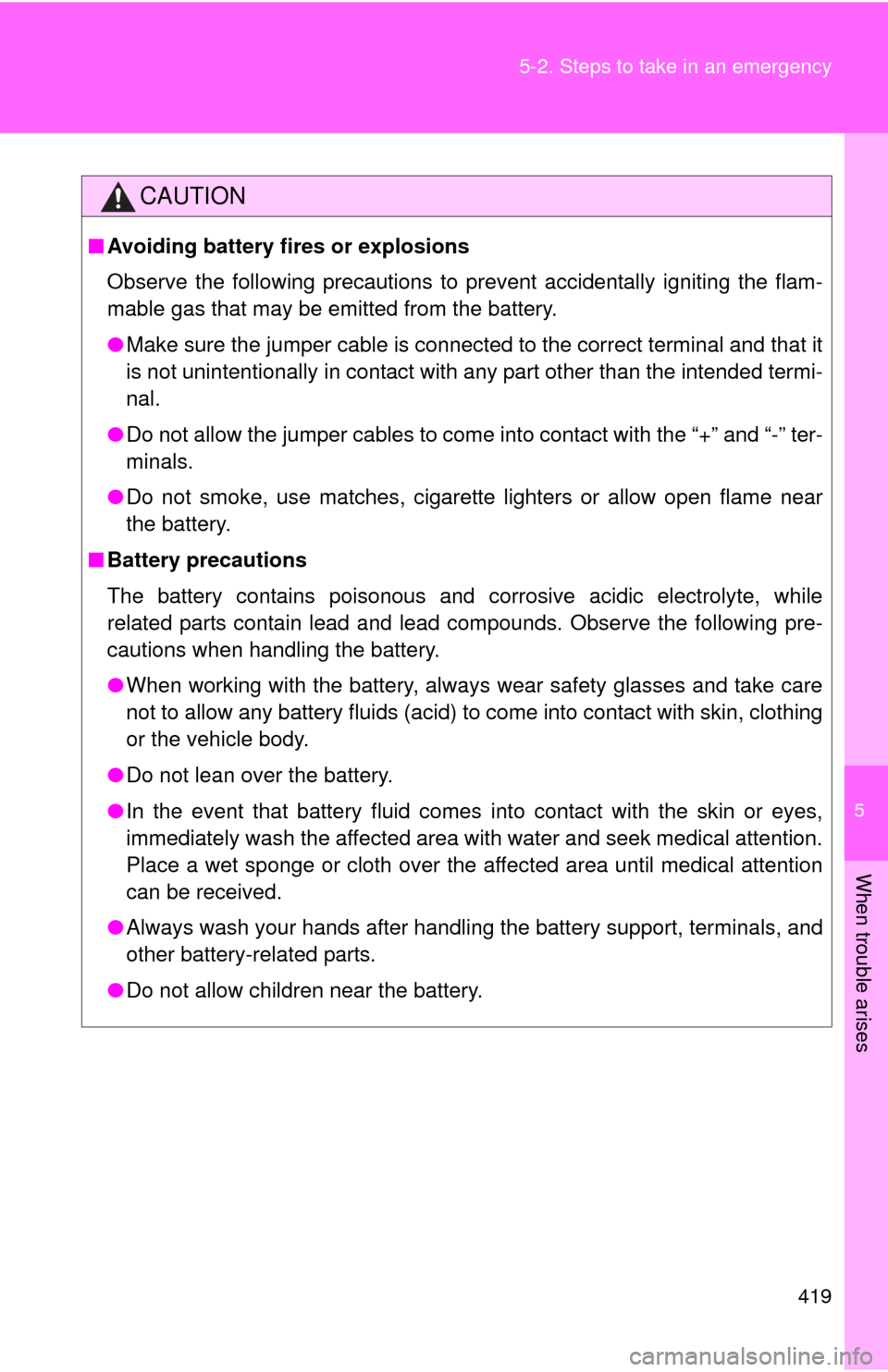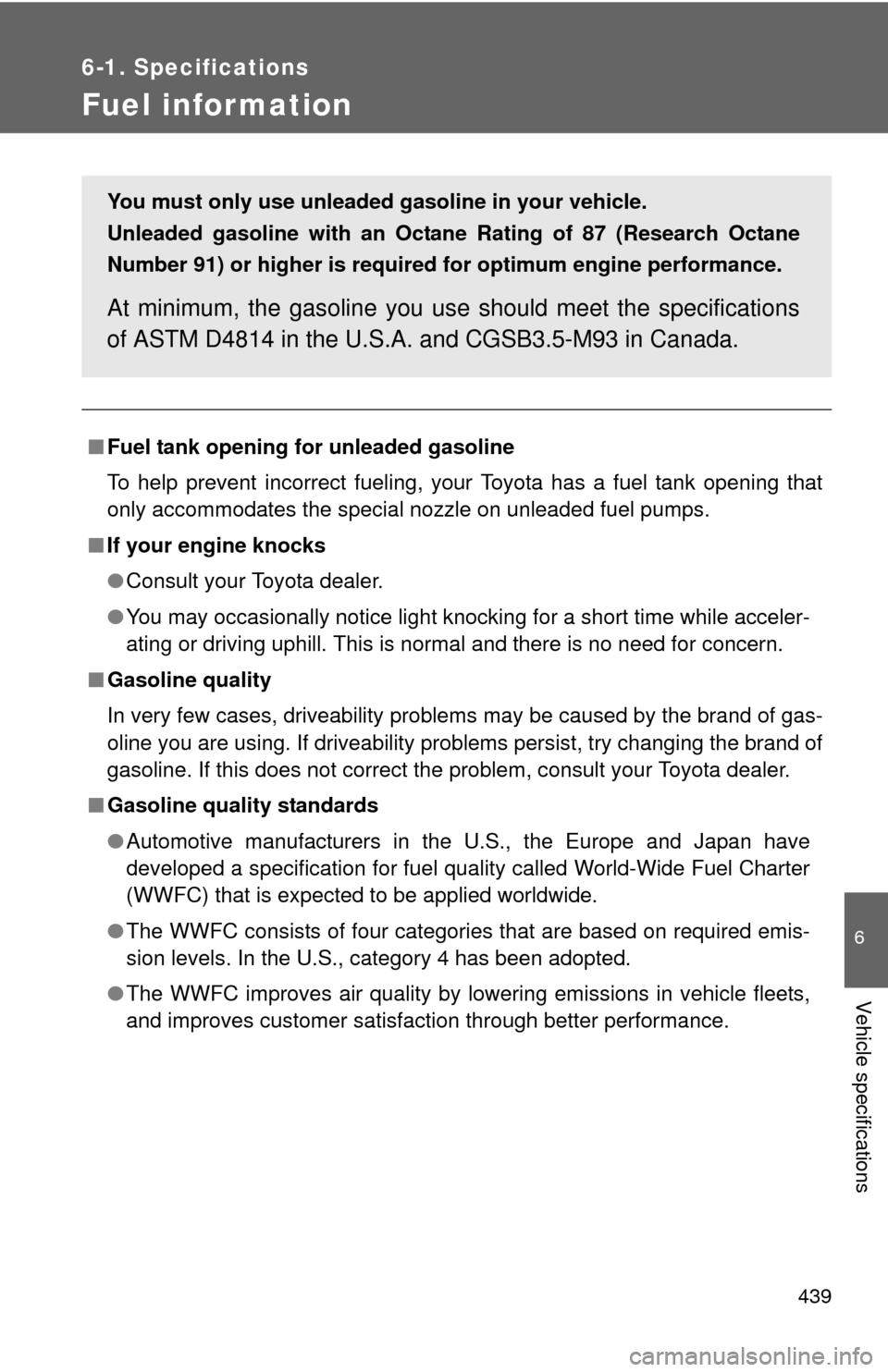Page 419 of 476

5
When trouble arises
419
5-2. Steps to take in an emergency
CAUTION
■
Avoiding battery fires or explosions
Observe the following precautions to prevent accidentally igniting the flam-
mable gas that may be emitted from the battery.
●Make sure the jumper cable is connected to the correct terminal and that it
is not unintentionally in contact with any part other than the intended termi-
nal.
● Do not allow the jumper cables to come into contact with the “+” and “-” ter-
minals.
● Do not smoke, use matches, cigarette lighters or allow open flame near
the battery.
■ Battery precautions
The battery contains poisonous and corrosive acidic electrolyte, while
related parts contain lead and lead compounds. Observe the following pre-
cautions when handling the battery.
●When working with the battery, always wear safety glasses and take care
not to allow any battery fluids (acid) to come into contact with skin, clothing
or the vehicle body.
● Do not lean over the battery.
● In the event that battery fluid comes into contact with the skin or eyes,
immediately wash the affected area with water and seek medical attention.
Place a wet sponge or cloth over the affected area until medical attention
can be received.
● Always wash your hands after handling the battery support, terminals, and
other battery-related parts.
● Do not allow children near the battery.
Page 420 of 476
420 5-2. Steps to take in an emergency
NOTICE
■To prevent damage to the vehicle
Do not pull- or push-start the vehicle, because the catalytic converter may
overheat and become a fire hazard.
■ When handling jumper cables
Be careful that the jumper cables do not become tangled in the cooling fans
or any of the belts when connecting or disconnecting them.
Page 422 of 476
422 5-2. Steps to take in an emergency
■Overheating
If you observe the following, your vehicle may be overheating.
●The engine coolant temperature gauge enters the red zone or a loss of
power is experienced.
● Steam is coming from under the hood.
CAUTION
■To prevent an accident or injury when inspecting under the hood of
your vehicle
● Keep hands and clothing away from the fan and other belts while the
engine is running.
● Do not loosen the coolant reservoir cap while the engine and radiator are
hot.
Serious injury, such as burns, may result from hot coolant and steam
released under pressure.
Add engine coolant if neces-
sary.
Water can be used in an emer-
gency if engine coolant is
unavailable.
(P. 433)
Have the vehicle chec ked at the nearest Toyota dealer as soon as
possible.
STEP6
Page 439 of 476

439
6-1. Specifications
6
Vehicle specifications
Fuel infor mation
■Fuel tank opening fo r unleaded gasoline
To help prevent incorrect fueling, your Toyota has a fuel tank opening that
only accommodates the special nozzle on unleaded fuel pumps.
■ If your engine knocks
●Consult your Toyota dealer.
● You may occasionally notice light knocking for a short time while acceler-
ating or driving uphill. This is normal and there is no need for concern.
■ Gasoline quality
In very few cases, driveability problems may be caused by the brand of gas-
oline you are using. If driveability problems persist, try changing the brand of
gasoline. If this does not correct the problem, consult your Toyota dealer.
■ Gasoline quality standards
●Automotive manufacturers in the U.S., the Europe and Japan have
developed a specification for fuel quality called World-Wide Fuel Charter
(WWFC) that is expected to be applied worldwide.
● The WWFC consists of four categories that are based on required emis-
sion levels. In the U.S., category 4 has been adopted.
● The WWFC improves air quality by lowering emissions in vehicle fleets,
and improves customer satisfaction through better performance.
You must only use unleaded gasoline in your vehicle.
Unleaded gasoline with an Octane Rating of 87 (Research Octane
Number 91) or higher is required for optimum engine performance.
At minimum, the gasoline you use should meet the specifications
of ASTM D4814 in the U.S.A. and CGSB3.5-M93 in Canada.
Page 462 of 476
462
Abbreviation list
Abbreviation/Acronym list
ABBREVIATIONSMEANING
A/C Air Conditioner
ABS Anti-Lock Brake System
ACC Accessory
ALR Automatic Locking Retractor
CAL Calibration
CRS Child Restraint System
DISP Display ECU Electronic Control Unit
EDR Event data recorderELR Emergency Locking Retractor
GAWR Gross Axle Weight Ratings
GVWR Gross Vehicle Weight Rating I/M Emission inspection and maintenance
LED Light Emitting Diode
MMT Methylcyclopentadiency Manganese Tricarbonyl
M + S Mud and Snow
MTBE Methyl Tertiary Butyl Ether OBD On Board DiagnosticsSRS Supplemental Restraint System
TIN Tire Identification Number
TPMS Tire Pressure Warning System TRAC Traction Control
VIN Vehicle Identification Number
VSC Vehicle Stability Control
Page 465 of 476

465
Alphabetical index
Daytime running light
system ................................... 154
Defogger Rear window......................... 199
Side mirror ............................ 199
Dimension ................................ 428
Dinghy towing .................. 181,182
Display Trip information .................... 149
Warning message ................ 391
Do-it-yourself maintenance .... 309
Door courtesy light
Door courtesy light ............... 264
Wattage ................................ 438
Doors Door glasses .......................... 68
Door lock .................... 26, 37, 41
Side mirrors ............................ 66
Driver's seat belt reminder light ........................................ 384
Driving Break-in tips ......................... 118
Correct posture....................... 82
Procedures ........................... 116
Winter driving tips ................. 169
Electronic key If your electronic key battery is
discharged ......................... 415
Emergency, in case of If a warning light turns on ..... 381
If a warning message is
displayed ............................ 391
If the electronic key does not
operate properly ................. 415
If the engine will not start...... 411
If the shift lever cannot be shifted from P ..................... 413
If the vehicle has discharged battery ................................ 417
If the warning buzzer sounds ............................... 381
If you have a flat tire ............ 400 If you lose your keys .............414
If you think something is
wrong ..................................377
If your vehicle becomes stuck ...................................424
If your vehicle needs to be towed ..................................374
If your vehicle overheats .......421
Engine Compartment ........................316
Engine switch ................126, 130
Hood......................................313
How to start the engine .........................126, 130
Identification number .............428
If the engine will not start ......411
Ignition switch................126, 130
Overheating...........................421
Engine compartment cover.....318
Engine coolant Capacity ................................433
Checking ...............................325
Preparing and checking before winter ..................................169
Engine coolan t temperature
gauge ......................................141
Engine immobilizer system.......77
Engine oil Capacity ................................431
Checking ...............................319
Preparing and checking before winter ..................................169
Engine oil maintenance data .........................................323
Engine switch light ..................264
Event data recorder .................379D
E
Page 471 of 476

471
Alphabetical index
Tachometer .............................. 141
Tail lights
Replacing light bulbs ............ 368
Switch ................................... 152
Wattage ................................ 438
Theft deterrent system Alarm ...................................... 79
Engine immobilizer system..... 77
Theft prevention labels ............. 81
Tire inflation pressure ............ 344 Tire information
Glossary ................................448
Size .......................................445
Tire identification number ......444
Uniform tire quality grading ...446
Tires Chains ...................................169
Checking ...............................334
If you have a flat tire ..............400
Inflation pressure...................344
Inflation pressure sensor .......336
Replacing ..............................400
Rotating tires .........................334
Size .......................................436
Snow tires .............................169
Spare tire...............................400
Tools .........................................400
Total load capacity...................168
Towing Dinghy towing................181, 182
Trailer towing.........................173
TRAC .........................................162
Traction control........................162
Trip information .......................149
Trip meter .........................141, 149
Trunk Extending a space................. 285
Opener ....................................46
Trunk light
Trunk light ...............................47
Wattage .................................438
Turn signal lights
Replacing light bulbs .............368
Switch....................................138
Wattage .................................438T